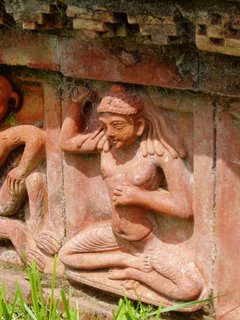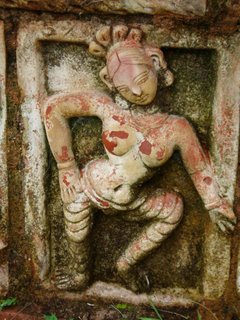To The Village

the hand weavers of tangail, bangladesh


the boys of our fifteen-member group
 nazneen, farjana, and zia terracotta work at paharpur
nazneen, farjana, and zia terracotta work at paharpur

 more terracotta and the yard of ruins at paharpur
more terracotta and the yard of ruins at paharpur

the central stupa at paharpur
Wednesday July 26, 2006 At seven am, a big red bus with green edging and a Bangladesh flag on the front parked outside the house ready to drive us five hours into the villageside of Bangladesh. It had been almost five weeks since we arrived to Bangladesh, and we had not left Dhaka at all. It was a welcomed trip. I have fallen in love with the flag of Bangladesh. It is green, like the lush landscape of Bangladesh, with one red circle in the middle for the blood that was shed to make this country in 1971. It love its simplicity and color variance, which is a bit analogous for my experience here in this land. Our destination was Bogra, and a hotel named the Naz Garden. Oh yes, we were roughing it at the four-star hotel in the middle of the village. They had a lovely pool, which ladies here swim in fully dressed. It is quite a site. I opted for the swimsuit, shorts and tank top combo. They also had a lake and paddleboats, which is great exercise. I need one of those in my backyard in Chicago. Paddleboat pond with fish. On day one of our trip we visited Mahasthan, which is the ruin site of a great ancient city of Bengal. Bengal was a great civilization, it's height being from the 8th century AD to the 12th century. The civilization was Buddhist and very advanced. Mahasthan was a centre of international trade and commerce. One could travel in any direction from there. North on the silk route to China or Tibet, East to Burma and Thailand, South to the Bay of Bengal and the Ocean (Asia, Africa, Middle East, Europe, Etc), and West to India. I love to visit sites like this because if you just relax yourself, and forget about worries of the present day, you can hear and feel the life that people led in the past in these places. It's something like imagination-intuition, with picture glimpses on the tv of the mind. Here in Bangladesh there is no preservation of historical sites, and very often time through history the exposed bricks of the ruins are re-used as building materials for something else. This sometimes still happens today. This trip was a secondary choice of our organizers. We at first wanted to go to Sylhet region of Bangladesh. These hill tracks of the Northeast region are home of many great Sufi lineages and hill tribal people. The rains this year have been heavy and the roads are washed out right now. Our second choice was Bogra region where we would visit and learn about old civilizations, philosophies, and traditions of Bengal. This is the heart of my study matter, so the change in trip location was like a dream come true.....which has also been a theme on this trip. Day two brought us to Somapura Vihara, the largest Buddhist University and learning center that existed south of Tibet. Today what you will see is the ruin layout of the entire temple complex and the remaining ruins of the huge stupa at the centre of the complex. In the museum of the site, we viewed incredible examples of small and large statues, everyday use items, including chillums, and holding vessels , and tools. The items were akin to the times and the Vajrayani lineage that prevailed here. This is one of the very important aspects of my intrest and research here and I was very happy to play imagination detective and try to figure out what certain structures were. There were 177 monks cells that surrounded the outer wall of the monastery. There was a kitchen area, a huge well, and many stupa resting in the front entrance. There were rooms for the abbots and head monks at the western entrance. This seems to be the main entrance of the complex as well. At the back of the eastern entrance sat a mandala room, that included a sixteen "star" pattern that looked more to me like a sixteen-peteled lotus design. It was so amazing to sit there a while and feel the energy vibrating through the stones and bricks. All along the main stupa in the center was terracotta tiles. These amazing art forms showed yogi and yogini, animals, scenes of nature and the natural Bengali form of that time. The basement level was excavated at one time where they discovered among many things seventy-two pedestals. Archeologists figured these were for statues that were long gone, but my thought is that these were for Padmasambhava's seventy-two wives: the sixty-four Yoginis and the eight Matrikas. Out of the Northern entrance and a few hundred meters back was the ruins of a Tara temple complex. It made me think that we must be only seeing a bit of what was really the grandeur of the Somapura Vihara. The village has surrounded the ruins, now a protected site. In this land of over-population every square meter counts. There must be more sites, in or under the villages that tell more of the story of what once existed here. On the final day of our trip, on our way back to Dhaka, we visited Tangail, the famous region of handloom cottom fabric. When we reached it was inbetween rainclouds. The ground outside the mud-walled, thatch roof dwellings was wet, and we made a bit of a mess as we entered house after house of traditonal weavers. The looms are still made of bamboo, with some metal pieces. The floors are mud. Strand by strand the threads are layed out and with other bamboo tools the woof and warf of the fabric is made. After looking and gawking came shopping. The scence was something out of a movie. Fifteen women in one little room of a weavers house, four chairs, and a rack of sari. It started to rain again outside quite heavily. People were shouting colors and design names over the sound of the rain, prices flying back and forth, fabic everywhere, students arguing who saw what one first, and of course what color would look best on them. An average sari was about 300-400 taka, about $5-6! The handloom silk sari were a bit more, but well worth their quality. I came out with only three, something I was pretty proud of. On the bus ride home I had pleny of time to think about things....something I seem to be doing a lot of lately. From Tangail it is not that far to Dhaka, but we ended up sitting in two hours of traffic just to get into the city. We crossed the Jamuna bridge, and engineering feat that is the longest bridge in South Asia. Then through some villages and then Gazipur. I saw lots of garment factories in Gazipur and it was here that the city stench entered the air. During this time, I pondered about the wonder of the civilization that was here, that today we viewed as museums and ruins. Bengal was so very advanced. This pluralistic culture existed in harmony with others, while advancing their own beliefs and scientific philosophies. Women and men lived as equals, there was education and health care for all, and necessities were in abundance. The philosophy that flourished was of oneness of all of creation, and respect for the multi-faceted expressions in nature. I find it so interesting to see all around the world the many enlightened cultures that lived, and most of them fell under the destruction of colonial rule. These people lived fine on their own. When you look to the crisis of poverty in Bangladesh today, it is not the result of a lack of knowledge in Bengali culture. It is a result of the natural system of living being destroyed by modern, material culture. Don't get me wrong, I am not in favor of turning back the clock and going back to caveman days. But I do feel the importance of knowing what has come before us, the traditons and stories, in order to draw upon this information and harmonize our modern life today. Bengal and Bangladesh is one of many places to look to for a store of knowledge. I think that's one of many reasons why I am here. |

0 Comments:
Post a Comment
<< Home